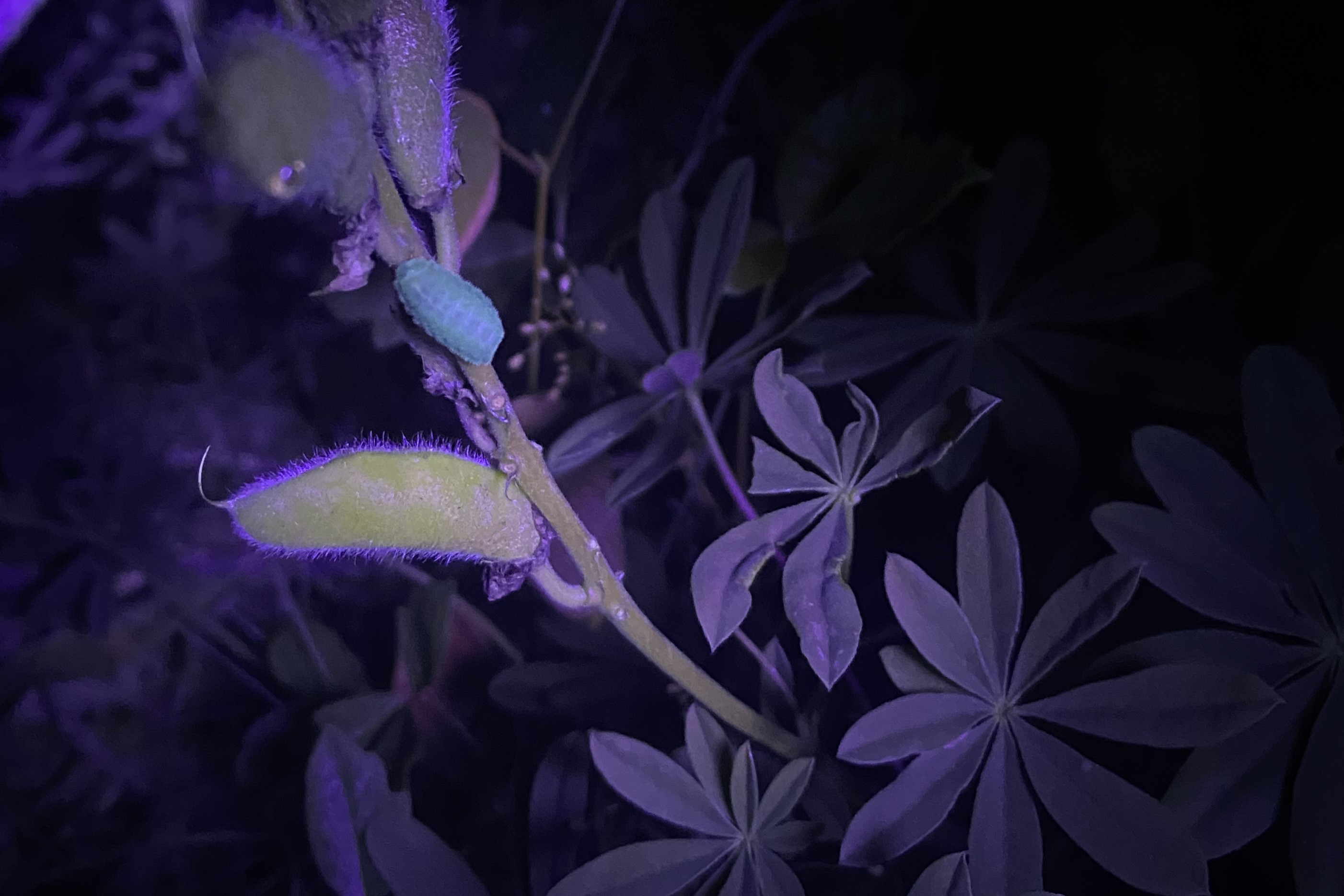
 Department of Conservation and Recreation
Department of Conservation and Recreation
Conserve. Protect. Enjoy.
 Department of Conservation and Recreation
Department of Conservation and Recreation
By Emi EndoPosted November 07, 2024

A green frosted elfin caterpillar blends in with its host plant.
A few small, green caterpillars captured in southeast Virginia this spring will be hunkering down this winter for their next phase of life in an unlikely place: Gainesville, Florida.
Courtesy of their hosts at the Florida Museum of Natural History at the University of Florida, these frosted elfin (Callophrys irus) butterflies-to-be are being reared in captivity in a new initiative aimed at fortifying the dwindling populations of the rare species in Virginia.
The Virginia team has enlisted the expertise of Dr. Jaret Daniels, director of the McGuire Center for Lepidoptera and Biodiversity at the Florida Museum, who specializes in butterflies, skippers and moths and imperiled species recovery.
Andrew Rapp, field zoologist in the Virginia Natural Heritage Program at DCR, said if the Daniels lab can rear new generations of the butterflies in Florida over the next couple of years, “then we can reintroduce them to a really nice habitat for them back here in Virginia. That’s our big goal with the captive rearing project.”

Frosted elfin butterfly.
“In addition to the captive rearing, augmenting the habitat for the frosted elfin is equally critical,” said Chief Biologist Anne Chazal. “We need to make sure that the reintroduced individuals have a place where they can thrive. We are taking steps to adjust our land management to promote the best possible outcome.”
The frosted elfin is a small butterfly with a wingspan of about 1 to 1.5 inches. The uppersides of the wings are plain dark brown/gray but the undersides have patterned stripes and a dusting of silver (“frosting”).
Unlike migrating butterflies such as the monarch butterfly, the frosted elfin lives out its entire year-long life cycle on and around one of two primary host plants: sundial lupine (Lupinus perennis) or yellow wild indigo (Baptisia tinctoria). Other potential host plants in Virginia include rattlebox (Crotalaria sagittalis) and blue wild indigo (Baptisia australis).
The butterfly’s flight season is from the beginning of April through May.

Caterpillar under black light.
Once found from Canada to Texas and Florida, the globally vulnerable species has gone extinct in Ontario, Maine and Illinois. In Virginia, they are critically imperiled. Rare Animals Summer 2024 list.
Frosted elfin populations are threatened by habitat loss because of development, fire suppression and other factors. Fewer suitable places for their host plants means fewer places where the butterflies can lay their eggs and feed.
The Virginia Natural Heritage Program, which works to protect the biodiversity of the commonwealth, has been tracking the species for decades.
It has been documented at two natural area preserves in southeastern Virginia. However, only a few individuals have been found in recent years.
This spring, staff detected adult butterfly populations at six locations across the state, including at the Fort Walker military base near Bowling Green, Virginia. While frosted elfins had not been encountered in Virginia’s mountains since 1994, they were discovered this year at two new sites in the mountains of western Virginia.
For the captive rearing project, Rapp and other staff zoologists visited patches of lupine plants in southeast Virginia with Daniels, who has extensive experience finding and rearing such caterpillars.
Using blacklights at night helped them to spot the green caterpillars on the green leaves of the host plants. In the evening, when it’s cooler, the caterpillars tend to be more active and come out to feed, Rapp said. “If you shine black lights on plants, the caterpillars reflect a slightly different color. It’s a little bit easier to actually detect them.”
Daniels returned to Florida with the caterpillars they collected and Rapp later sent another one found at Fort Walker.
The larvae have pupated and will spend the next several months in a chrysalis-state in the soil until emerging as adults in about April. The lab will also gather genetic samples from the frosted elfin for further study.
Rapp plans to search for additional caterpillars in the spring.
With the next generations of frosted elfins from the captured caterpillars, Rapp said, “We would boost the populations that we have to reestablish them within their range.”
Categories
Conservation | Native Plants

